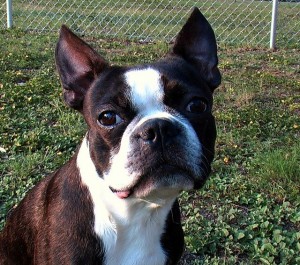 The Boston Terrier is small breed dog that originated from Boston, Massachusetts. In the 1870’s, Robert C. Hooper purchased a Bulldog and English White Terrier mixed breed dog named Judge. He interbred Judge with French Bulldogs to produce the Boston Terrier. The breed was originally bred for dog fighting and rat hunting purposes. They were later specifically bred to be companion animals. The original Boston Terrier was larger than today’s and weighed up to 44 lbs. They were increasingly bred to be smaller in size and to distance their bloodlines from those of the fighting breeds in their heritage. Today, companion lines of Boston Terriers retain very little of the terrier traits and are not considered terriers by the AKC. The breed was recognized by the AKC in 1893 and was the first American breed to be recognized.
The Boston Terrier is small breed dog that originated from Boston, Massachusetts. In the 1870’s, Robert C. Hooper purchased a Bulldog and English White Terrier mixed breed dog named Judge. He interbred Judge with French Bulldogs to produce the Boston Terrier. The breed was originally bred for dog fighting and rat hunting purposes. They were later specifically bred to be companion animals. The original Boston Terrier was larger than today’s and weighed up to 44 lbs. They were increasingly bred to be smaller in size and to distance their bloodlines from those of the fighting breeds in their heritage. Today, companion lines of Boston Terriers retain very little of the terrier traits and are not considered terriers by the AKC. The breed was recognized by the AKC in 1893 and was the first American breed to be recognized.
The companion lines of Boston Terriers are energetic, happy and outgoing dogs. They generally make great companion pets and will bond strongly to their families. Due to their strong family bond they may be protective of their owners. They are considered gentle, intelligent, and affectionate pets. They seldom bark and can make excellent companions for families in community living situations. Being purposefully bred to be companion animals, they usually get along great with children and strangers. Like all dogs, they haven’t lost all the traits needed for their original job. Some Boston Terriers can be aggressive with other dogs or with small 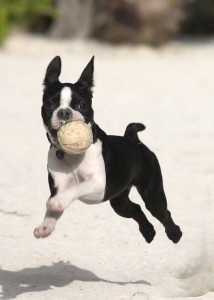 pets in the household. Boston Terriers can have a stubborn streak and are known to be difficult to housebreak. They can be messy dogs and can excessively drool or may have gas if not on a proper diet.
pets in the household. Boston Terriers can have a stubborn streak and are known to be difficult to housebreak. They can be messy dogs and can excessively drool or may have gas if not on a proper diet.
Boston Terriers need regular physical and mental stimulation. They enjoy walks or play time with their families. If they are not exercised daily, they can become high strung and hyper active. Early socialization is beneficial, but due to their later breed history they generally are highly social dogs. Even with proper training and socialization, they may have unwanted behaviors.
The Boston Terrier is responds well to positive reinforcement training by a gentle handler. They are very sensitive to tone of voice and needs a trainer that will accommodate to their needs.
Boston Terriers are a brachycephalic breed. Their heads have long palates, narrow tracheas, and small nostrils. Due to this anatomy design, they have breathing difficulties, snort, snore, and gag, and may reverse sneeze. They are high-risk dogs to put under anesthesia and caution should be taken with surgeries. Being brachycephalic, they are not suited for excessive heat and precautions should be taken during the summer months and while exercising.
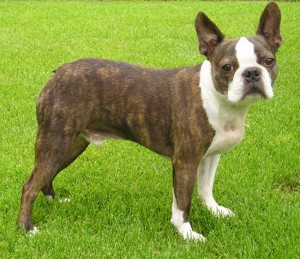 The Boston Terrier requires minimal grooming and is an average shedder. They are prone to medical issues such as eye problems, allergies, digestive issues, heart murmurs, deafness, mast cell tumors, and luxating patellas. Many Boston Terriers cannot give birth naturally and often require a caesarean delivery. The Boston Terrier typically weighs 10-25 lbs. A Boston Terrier may not weigh more than 25 lbs. Their height is 15 – 17 inches, and their average lifespan is 11-15 years. If someone tries to sell you a larger dog as a Boston Terrier, please see our caution below.
The Boston Terrier requires minimal grooming and is an average shedder. They are prone to medical issues such as eye problems, allergies, digestive issues, heart murmurs, deafness, mast cell tumors, and luxating patellas. Many Boston Terriers cannot give birth naturally and often require a caesarean delivery. The Boston Terrier typically weighs 10-25 lbs. A Boston Terrier may not weigh more than 25 lbs. Their height is 15 – 17 inches, and their average lifespan is 11-15 years. If someone tries to sell you a larger dog as a Boston Terrier, please see our caution below.
CAUTION: If you are looking for a Boston Terrier, it’s important to know about two similar, related ‘breeds’ of dog. Some breeders may try to tell you that these are Boston Terriers. They are not.
1) The ‘American Boston Bulldog’
The ‘American Boston Bulldog’ is not a recognized breed, and it is not a Boston Terrier. The ‘American Boston Bulldog’ is a cross between the American Pit Bull Terrier and the Boston Terrier – ie, an ordinary pit bull mix someone gave a handy name to. The American Boston Bulldog is usually smaller than a pit bull, but larger and heavier than a Boston Terrier. As a pit bull mix, The American Boston Bulldog will present the same dangers and problems as any pit bull or pit bull mix, especially for children, the elderly, and other animals. It is not a companion dog, though its size (usually somewhat smaller than a pure pit bull) could make attacks easier to stop without risking your life.
Photo from: http://www.dogbreedinfo.com/a/americanbostonbullterrier.htm
2) The ‘Olde Boston Bulldogge’
The ‘Olde Boston Bulldogge’ is not a recognized breed and it is not a Boston Terrier. The ‘Olde Boston Bulldogge’ was created by hobbyists who are interested in resurrecting the fighting history and aggressive traits of the original Elizabethan bull-baiting, horse-mauling bulldogs. Like the ‘Olde English Bulldogge’, the ‘Olde Boston Bulldogge’ is not a companion dog but a fighting bulldog. The fans proudly call it ‘the original Bull and Terrier from which the Boston Terrier was developed’. It is a return to the fighting bulldog – terrier mix as it was used in Boston for covert dogfighting. Hundreds of years of breeding to create a small, purely companion dog have been erased in the ‘Olde Boston Bulldogge’. The so-called Olde Boston Bulldog weighs from 25 – 45 lbs, large enough to seriously damage a child, an elderly person, and other animals. This mix is also advertised as ‘Boston Bulldog’ and ‘Boston Bull’.
Photo from: http://www.dogbreedinfo.com/oldebostonbulldogge.htm
If you are looking for a Boston Terrier, be sure to go to a reputable breeder and get an AKC registered Boston Terrier pup.
In North America, from 1982-2013, Boston Terriers have seriously attacked 2 humans.
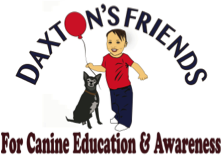
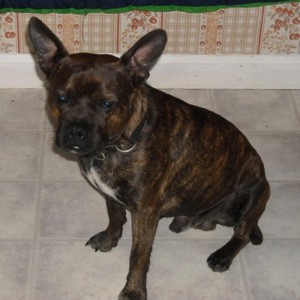
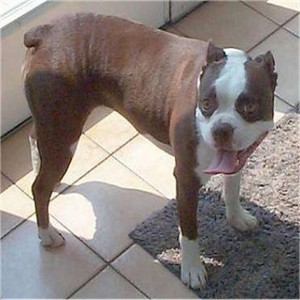
Can you share your reference for Boston Terriers produced or used for dog fighting? I’ve read every book I can find online which was authored in the first decades of the breed’s introduction and have yet to see ANY mention of the Boston Terrier ever used in fighting or matches or any sort of violence whatsoever. The dogs used in the breed were of bulldog and terrier type yet were from the beginning meant to be show dogs and companions for gentlemen, ladies and family, not fighting dogs or even working dogs of any sort. Please consult Axtell (the early books can be read online) and similar early 1900s books for the breed’s history as using the internet for reference is often like playing telephone, as we’ve seen in the case of the nanny dog myth.
Is there a link or report to reference for the “Seriously attacked 2 humans” involving the Bostons? I know of the fatality with the elderly lady who died in the hospital from bite wound complications as those two dogs were filmed while in custody and were sadly very small Bostons. I have seen one other fatality case where the breed was marked “Boston Terrier” yet no photo or description of the dog and it was with a group of other dogs.
Sadly one can see the way backyard breeders have cleverly manipulated the breed and inbreeding with siblings and pitbull mixes to resemble the pure bred Boston. We have one such mix ourselves – a sad sad product of this inhumane breeding resulting in a hyper reactive, hypersensitive and aggressive personality that is impossible to socialize or train. Our vet has suggested Prozac as a short term measure to help the dog learn basic obedience skills. #bewarebackyardbostonbreeders